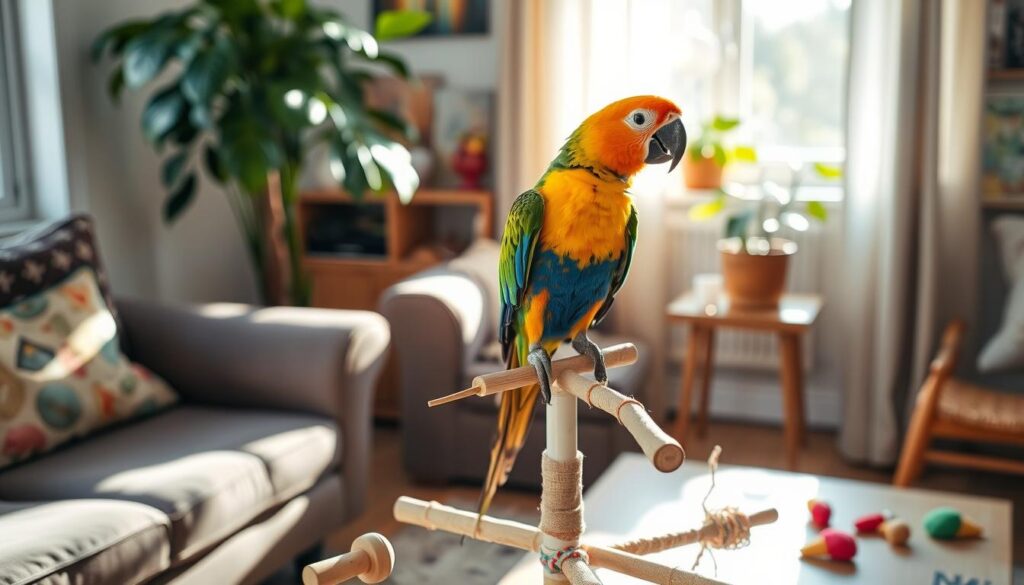Bringing a new bird home is an experience filled with excitement and anticipation. Just last month, a friend shared her story about adopting a charming budgie named Kiwi. She was thrilled, but also anxious, knowing how sensitive birds can be to their environment. She decided to prepare her home meticulously, creating a thoughtful space for Kiwi to feel secure. By taking the time to understand how to introduce a new bird to her home, she made the transition smoother not just for Kiwi, but for herself as well. This journey taught her valuable bird introduction tips that we can all learn from.
In this guide, we’ll explore the essential steps for welcoming a new bird into your family. From creating a supportive environment to building a trusting relationship, every detail matters. By understanding the bird acclimation process and establishing routines, you can ensure that your new feathered friend feels right at home. Let’s dive into how to set the stage for a positive experience through compassionate care and attention.
Key Takeaways
- Acclimation is key—allow your bird time to adjust to its new cage and surroundings.
- Use familiar items and soothing talk to make your new pet feel secure.
- Introduce toys based on your bird’s preferences to enrich their habitat.
- Handling should be gentle and gradual to earn your bird’s trust.
- Three days of peace can make all the difference for your new bird.
- Observing your bird’s body language helps build a stronger bond.
Preparing Your Home for a New Bird
Preparing your home for a new bird involves thoughtful planning to ensure a welcoming atmosphere. Birds thrive in environments where they feel secure, so identifying a suitable location within your space is essential. A quiet area away from high traffic zones will minimize stress and help your feathered friend acclimatize more easily.
Choosing the Right Space for Your Bird
Selecting the perfect spot for your bird goes beyond mere aesthetics. Aim for an area that avoids direct sunlight and drafts, as these can cause discomfort. By providing a peaceful setting, you make it easier for your new bird to settle into its new home and feel comfortable.
Essential Supplies You’ll Need
Gathering essential supplies for bird care is a crucial step in creating a new home. A well-ventilated cage, appropriate perches, and safe food and water dishes should be at the top of your list. Adding toys will not only prevent boredom but also engage your bird in mental and physical activity, enhancing its overall well-being.
Creating a Safe Environment
Creating a safe habitat for birds involves thorough preparation. Begin by removing any hazards such as toxic plants and small objects that could be ingested. Ensure that other pets are kept calm and away from your new bird during its adjustment period. Additionally, using items like decals on windows can prevent accidents when your bird is out of its cage, enhancing overall safety.
Introducing Your New Bird to Its Cage
Welcoming a new bird into your home is an exciting time filled with special moments. Introducing a pet bird to its cage requires thoughtful planning to ensure a seamless transition. A crucial aspect of this process is selecting a bird cage that caters to the specific needs of your feathered companion.
Selecting the Perfect Cage
When selecting bird cage, consider the size and type of bird you have. The cage should provide ample space for movement, climbing, and playing. Opt for a cage that is spacious enough to accommodate appropriate perches and toys for birds. This setup not only promotes self-exploration but also contributes to your bird’s overall well-being. Look for cages that offer sturdy construction and safe materials to foster a secure environment.
Adding Perches and Toys
Creating a captivating environment within the cage can greatly enrich your bird’s life. Choose appropriate perches and toys for birds that cater to their natural behaviors. Including various perch sizes and textures encourages exercise and foot health. Introduce interactive toys that stimulate your bird’s curiosity and intelligence, helping them to feel more at home. Be sure to regularly rotate these items to maintain their interest and engagement.
Ensuring Proper Ventilation
Proper ventilation is essential for your bird’s health. Ensure the cage is placed in a well-ventilated area, and avoid drafts that could cause discomfort or illness. A well-ventilated space provides fresh air and minimizes the risk of respiratory issues. Allow your new bird to familiarize itself with its surroundings at its own pace. Incorporating familiar objects can provide comfort and aid in the adjustment process.

The First Days: Establishing Trust
The first days with your new bird are crucial for laying the foundation of a trusting relationship. It’s essential to create a calming atmosphere, minimizing overwhelming stimuli such as loud noises or fast movements. This environment helps ease your bird’s transition, allowing it to acclimate gradually.
Avoiding Overwhelming Stimuli
During this adjustment period, keeping the noise level low and interactions gentle aids in establishing trust with your bird. Birds are sensitive creatures, and too much excitement can evoke stress. Observing the reactions of your bird can guide you in maintaining a comfortable atmosphere, enabling it to feel secure in its new home.
Setting a Routine for Interaction
Establishing a consistent bird interaction routine fosters a sense of security. Engaging in daily activities, such as soft talking or offering treats, reinforces a positive association with your presence. Gradually, your bird will become accustomed to your schedule and begin to feel more at home. This interaction will help shape your bird’s comfort level, leading to deeper bonding as it becomes familiar with your daily life.

Building trust is a journey that requires patience, especially with rescue birds that may have experienced hardships. By focusing on gentle interactions and maintaining a routine, you can create a nurturing environment where your bird thrives, ultimately enriching both your lives. For more insights on handling the emotional aspects of relationships, check out this resource.
Socializing Your Bird Safely
Socializing your new bird is fundamental for creating a happy and healthy environment. Fostering a trusting relationship can be accomplished through understanding bird body language and gradually increasing interaction. By observing your bird’s natural responses, you can tailor your approach for a positive experience that enhances bonding.
Understanding Body Language
Recognizing bird body language is crucial in socializing your pet effectively. Birds communicate largely through posture and movements. For instance, a relaxed stance may indicate comfort, while fluffed feathers or a puffed-up appearance could signal stress or discomfort. Pay close attention to your bird’s signals to ensure interactions are enjoyable.
Gradually Increasing Interaction
Introducing short sessions of interaction initially helps in building trust. Starting with brief periods of gentle talk or light play will allow your bird to adjust to your presence. Gradually increasing interaction time gives your bird confidence, promoting a positive connection between the two of you. This slow progression is especially important for older birds who may have developed habits or fears over time.
Establishing a Bond Through Play
Bonding with your pet bird through play offers both mental and physical engagement. Utilize favorite toys and initiate fun activities, encouraging your bird to explore and interact with you. Positive reinforcement during these play sessions fosters trust and strengthens your connection. Friends and family can also participate by engaging with your bird, using treats to encourage stepping up and responding to cues.

Nutrition and Health Care Essentials
Ensuring the well-being of your bird starts with a focus on bird nutrition and health care. Integrating a well-balanced diet is vital for your pet’s vibrancy and longevity. Understanding how to choose the right bird diet tailored to your specific species is equally important. This involves providing a variety of seeds, pellets, fresh fruits, and vegetables that cater to the unique dietary requirements of your bird.
Choosing the Right Diet
Choosing the right bird diet involves more than just filling the food bowl. It’s essential to ensure a diverse selection of nutritious options. Birds benefit greatly from fresh fruits and vegetables, which can enhance their health and quality of life. Regularly rotating food types can maintain their interest and stimulate their appetite.
Identifying Signs of Illness
Recognizing bird illness symptoms early is key to effective care. Monitoring behavioral changes, such as increased fluffiness or a change in droppings, can provide critical insights into your bird’s health status. Keeping an eye on their activity levels and appetite will aid in identifying potential concerns before they escalate.
Scheduling Initial Vet Visits
Scheduling initial vet visits is an essential step in your bird’s health care plan. A thorough examination by an avian vet can help detect health issues early, ensuring your bird receives the best care possible. Establishing a regular check-up routine lays the foundation for ongoing monitoring, which is vital for promoting a long, healthy life.
Long-Term Care and Enrichment
Ensuring your pet bird’s happiness and health demands attention to long-term bird care, which includes creating a stimulating habitat that offers mental engagement and comfort. A well-rounded environment should consist of rotating toys, newly added perches, and interactive activities mimicking their natural behaviors. This careful consideration of bird habitat enrichment is essential in combating boredom, leading to a more content feathered friend.
Creating a Stimulating Habitat
Understanding a bird’s lifespan is crucial for lifelong care for pet birds, as their needs will evolve over time. Keeping abreast of these changes allows owners to proactively adjust their care strategies, ensuring that adaptations in their habitat and routine correlate with the bird’s development. Many pet birds form strong bonds with their owners, often preferring human companionship over that of other birds, making it essential to foster a captivating home environment.
Understanding Lifespan and Lifelong Care
Regularly re-evaluating your bird’s needs is also key for long-term happiness. As circumstances change—whether due to aging, health issues, or shifts in behavior—taking the time to assess how to better meet your pet’s requirements can significantly enhance their quality of life. Understanding how to create a harmonious living situation in a multi-pet household, while being aware of natural instincts—like a cat’s predatory behavior—can further support a safe and engaging environment.
Regularly Re-evaluating Bird Needs
To promote a loving and engaging relationship with your pet, remain attentive to its emotional contentment and physical well-being. The art of maintaining a happy bird goes beyond simply providing food; it involves fostering an enriching space that encourages exploration and interaction. By adopting these principles of long-term care, you are securing a brighter, more fulfilling future for both you and your feathered companion.











